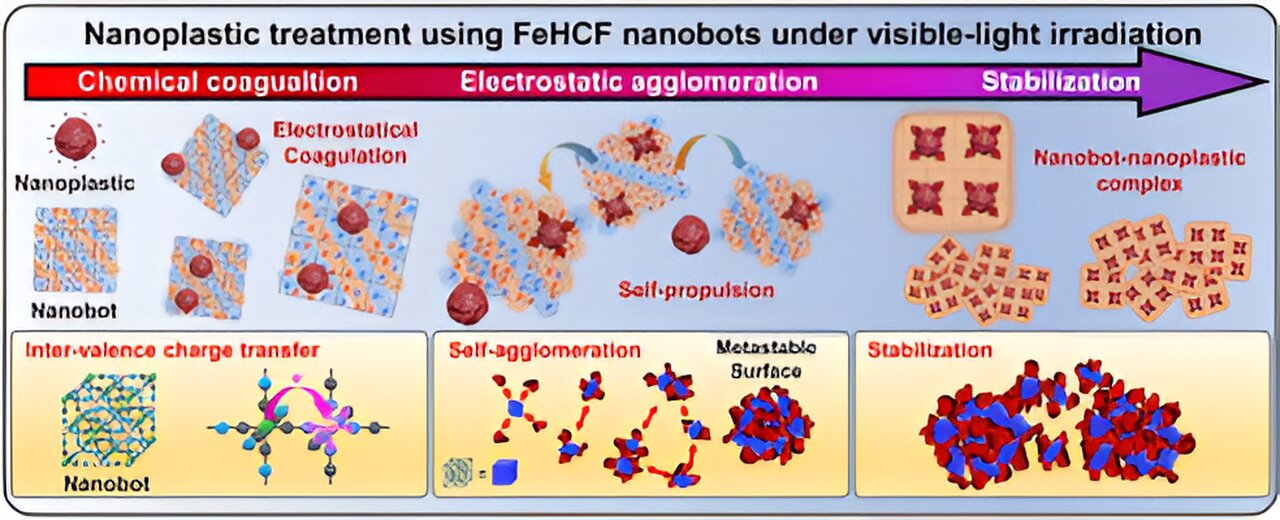
The fungus (in red) collected all of the green plastic nanoparticles onto the first fungal threads encountering the polluted area, and cleaned up its surroundings.
(Photo: Mafla Endara)
Using micro-engineered soil models, researchers at Lund University in Sweden have investigated the effect of tiny polystyrene particles on bacteria and fungi. While these nanoplastics reduced both bacterial and fungal growth, the fungus actually managed to “clean up” their surroundings, thereby easing the effect of the plastics.
“Plastic waste is a huge global problem. Whether carelessly discarded into nature, leaking from landfills or scoring from materials such as car tires and synthetic clothes – large amounts of micro- and nanoplastics end up in our soils,” says Micaela Mafla Endara, biology researcher at Lund University.
Nanoplastics have been proven to induce toxicity in diverse organisms, yet very little is known how this new pollutant is affecting the soil ecosystem. To study these nanoparticles of polystyrene, the researchers used microfluidic chips, a growth system that allowed them to observe interactions of single cells with the plastics under the microscope.
“At the highest nanoplastics concentration, the fungi caught most of the tiny plastics present in their vicinity, in a process that we labelled the ‘vacuum cleaner effect’. Overall, we found that nanoplastics can cause a direct negative effect on the soil microbes. This highlights the need for further studies that can explain how the microbial stress response might affect soil functions,” says Micaela Mafla Endara.
The nanoplastic particles clung to the surface of the fungal branches in such a way that the surroundings were almost nanoplastic-free. The fungus cleaned up its surroundings under high concentrations, and could then grow better again. Although the results of the study were confirmed for many conditions, the researchers point out that it might be species dependent.
“This serves as a reminder to reduce our plastic waste and the pollution of soils. Finding fungi that can specifically collect nanoplastics from the soil solution may help other organisms to sustain the pollution better, and perhaps attract bacteria that can break down plastics. The fungal “vacuum cleaner” is not an easy fix for the problem, but can give a little hope for the future,” concludes Edith Hammer, biology researcher at Lund University.
Original Article: Vacuum cleaner-effect in fungi can hold nanoplastics at bay
More from: Lund University
The Latest Updates from Bing News
Go deeper with Bing News on:
Nanoplastics in soil
- The presence of microplastics in archaeology sites could prompt a major industry rethink
Typically archaeologists try to leave artefacts in their original resting position But the concern is that plastics could toxify deposits, maybe prompting excavation Microplastics are everywhere, ...
- What are microplastics doing to human health? Scientists work to connect dots
But plastic also litters waterways, soil and air so humans and other animals wind up ... or about the size of a sesame seed. Nanoplastics are flecks too small to be noticed by the human eye with ...
- What are microplastics doing to human health? Scientists work to connect the dots
People unknowingly ingest microplastics from what we eat, drink and breathe. Some scientists fear exposure to microplastics could increase vulnerability to heart disease, cancer and other illnesses.
- How microplastics can impact health, as plastic wet wipes to be banned in UK
Once in the waterways, soil, and general environment ... who had undergone surgery to remove it. They discovered micro or nanoplastics in more than half of the samples. It was also found that ...
- Port communities focus local Earth Day on international theme: plastic pollution
Healthy Port Communities Coalition, a group of local nonprofits and community groups, plans to make Earth Day celebrations an annual tradition.
Go deeper with Bing News on:
Nanoplastics
- Toxic Chemicals From Microplastics Can Be Absorbed By The Skin, Study Finds
A new study demonstrates how flame retardant additives in microplastics become absorbed by the skin and enter the bloodstream ...
- The presence of microplastics in archaeology sites could prompt a major industry rethink
A team of scientists discovered microplastics at an archaeology site in York, which potentially have major consequences.
- What are microplastics doing to human health? Scientists work to connect dots
Microplastics are tiny particles less than than five millimetres in diameter, or about the size of a sesame seed. Nanoplastics are flecks too small to be noticed by the human eye with diameters of ...
- What are microplastics doing to human health? Scientists work to connect the dots
People unknowingly ingest microplastics from what we eat, drink and breathe. Some scientists fear exposure to microplastics could increase vulnerability to heart disease, cancer and other illnesses.
- Are nonstick pans safe? What to know.
“The safest bet is to not purchase a pan that is marketed as nonstick, and choose cast iron or carbon steel,” says Stoiber. Choosing other types of cookware without PFAS — which can also include ...










